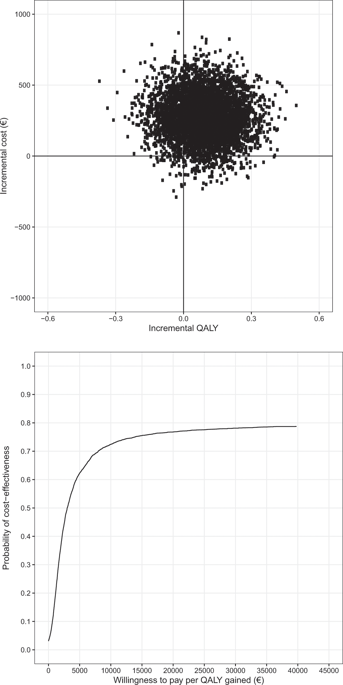当前位置:
X-MOL 学术
›
Int. J. Obesity
›
论文详情
Our official English website, www.x-mol.net, welcomes your
feedback! (Note: you will need to create a separate account there.)
Cost-effectiveness of a mobile health-supported lifestyle intervention for pregnant women with an elevated body mass index.
International Journal of Obesity ( IF 4.2 ) Pub Date : 2020-01-21 , DOI: 10.1038/s41366-020-0531-9 Elizabeth J O'Sullivan 1, 2 , Slawa Rokicki 3, 4 , Maria Kennelly 1 , Kate Ainscough 1 , Fionnuala M McAuliffe 1
International Journal of Obesity ( IF 4.2 ) Pub Date : 2020-01-21 , DOI: 10.1038/s41366-020-0531-9 Elizabeth J O'Sullivan 1, 2 , Slawa Rokicki 3, 4 , Maria Kennelly 1 , Kate Ainscough 1 , Fionnuala M McAuliffe 1
Affiliation

|
OBJECTIVE
To assess the cost-effectiveness of a mobile health-supported lifestyle intervention compared with usual care.
METHODS
We conducted a cost-effectiveness analysis from the perspective of the publicly-funded health care system. We estimated costs associated with the intervention and health care utilisation from first antenatal care appointment through delivery. We used bootstrap methods to quantify the uncertainty around cost-effectiveness estimates. Health outcomes assessed in this analysis were gestational weight gain (GWG; kg), incidence of excessive GWG, quality-adjusted life years (QALYs), and incidence of large-for-gestational-age (LGA). Incremental cost-effectiveness ratios (ICERs) were calculated as cost per QALY gained, cost per kg of GWG avoided, cost per case of excessive GWG averted, and cost per case of LGA averted.
RESULTS
Total mean cost including intervention and health care utilisation was €3745 in the intervention group and €3471 in the control group (mean difference €274, P = 0.08). The ICER was €2914 per QALY gained. Assuming a ceiling ratio of €45,000, the probability that the intervention was cost-effective based on QALYs was 79%. Cost per kg of GWG avoided was €209. The cost-effectiveness acceptability curve (CEAC) for kg of GWG avoided reached a confidence level of 95% at €905, indicating that if one is willing to pay a maximum of an additional €905 per kg of GWG avoided, there is a 95% probability that the intervention is cost-effective. Costs per case of excessive GWG averted and case of LGA averted were €2117 and €5911, respectively. The CEAC for case of excessive GWG averted and for case of LGA averted reached a confidence level of 95% at €7090 and €25,737, respectively.
CONCLUSIONS
Results suggest that a mobile-health lifestyle intervention could be cost-effective; however, a better understanding of the short- and long-term costs of LGA and excessive GWG is necessary to confirm the results.
中文翻译:

移动健康支持生活方式干预对体重指数升高的孕妇的成本效益。
目的 评估移动健康支持的生活方式干预与常规护理相比的成本效益。方法我们从公费医疗体系的角度进行成本效益分析。我们估计了与从第一次产前保健预约到分娩的干预和医疗保健利用相关的成本。我们使用 bootstrap 方法来量化围绕成本效益估计的不确定性。该分析中评估的健康结果包括妊娠体重增加 (GWG; kg)、过度 GWG 的发生率、质量调整生命年 (QALY) 和大于胎龄 (LGA) 的发生率。增量成本效益比 (ICER) 计算为每 QALY 获得的成本、每公斤避免的 GWG 成本、每例避免过多 GWG 的成本和每例避免 LGA 的成本。结果 包括干预和医疗保健利用在内的总平均成本,干预组为 3745 欧元,对照组为 3471 欧元(平均差异为 274 欧元,P = 0.08)。每增加一个 QALY,ICER 为 2914 欧元。假设上限比率为 45,000 欧元,根据 QALYs 干预具有成本效益的可能性为 79%。避免的每公斤 GWG 成本为 209 欧元。避免的 GWG 公斤的成本效益可接受曲线 (CEAC) 达到了 95% 的置信水平,为 905 欧元,这表明如果人们愿意为每公斤避免的 GWG 支付最多 905 欧元,则有 95干预具有成本效益的可能性百分比。每例避免过多 GWG 和避免 LGA 的成本分别为 2117 欧元和 5911 欧元。对于避免过多 GWG 的情况和避免 LGA 的情况,CEAC 的置信水平分别为 7090 欧元和 25,737 欧元,达到了 95%。结论 结果表明,移动健康生活方式干预可能具有成本效益;然而,需要更好地了解 LGA 和过多 GWG 的短期和长期成本,以确认结果。
更新日期:2020-01-21
中文翻译:

移动健康支持生活方式干预对体重指数升高的孕妇的成本效益。
目的 评估移动健康支持的生活方式干预与常规护理相比的成本效益。方法我们从公费医疗体系的角度进行成本效益分析。我们估计了与从第一次产前保健预约到分娩的干预和医疗保健利用相关的成本。我们使用 bootstrap 方法来量化围绕成本效益估计的不确定性。该分析中评估的健康结果包括妊娠体重增加 (GWG; kg)、过度 GWG 的发生率、质量调整生命年 (QALY) 和大于胎龄 (LGA) 的发生率。增量成本效益比 (ICER) 计算为每 QALY 获得的成本、每公斤避免的 GWG 成本、每例避免过多 GWG 的成本和每例避免 LGA 的成本。结果 包括干预和医疗保健利用在内的总平均成本,干预组为 3745 欧元,对照组为 3471 欧元(平均差异为 274 欧元,P = 0.08)。每增加一个 QALY,ICER 为 2914 欧元。假设上限比率为 45,000 欧元,根据 QALYs 干预具有成本效益的可能性为 79%。避免的每公斤 GWG 成本为 209 欧元。避免的 GWG 公斤的成本效益可接受曲线 (CEAC) 达到了 95% 的置信水平,为 905 欧元,这表明如果人们愿意为每公斤避免的 GWG 支付最多 905 欧元,则有 95干预具有成本效益的可能性百分比。每例避免过多 GWG 和避免 LGA 的成本分别为 2117 欧元和 5911 欧元。对于避免过多 GWG 的情况和避免 LGA 的情况,CEAC 的置信水平分别为 7090 欧元和 25,737 欧元,达到了 95%。结论 结果表明,移动健康生活方式干预可能具有成本效益;然而,需要更好地了解 LGA 和过多 GWG 的短期和长期成本,以确认结果。











































 京公网安备 11010802027423号
京公网安备 11010802027423号